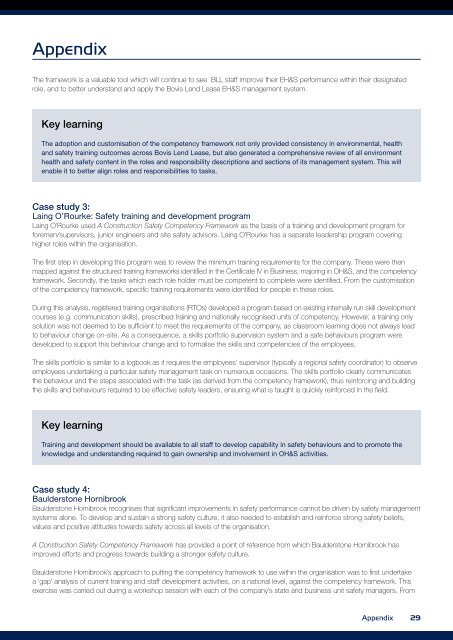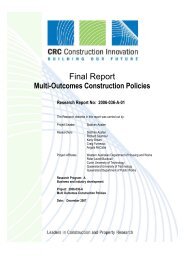A Practical Guide to Safety Leadership Book (PDF 5MB) - QUT ePrints
A Practical Guide to Safety Leadership Book (PDF 5MB) - QUT ePrints
A Practical Guide to Safety Leadership Book (PDF 5MB) - QUT ePrints
You also want an ePaper? Increase the reach of your titles
YUMPU automatically turns print PDFs into web optimized ePapers that Google loves.
Appendix<br />
The framework is a valuable <strong>to</strong>ol which will continue <strong>to</strong> see BLL staff improve their EH&S performance within their designated<br />
role, and <strong>to</strong> better understand and apply the Bovis Lend Lease EH&S management system.<br />
Key learning<br />
The adoption and cus<strong>to</strong>misation of the competency framework not only provided consistency in environmental, health<br />
and safety training outcomes across Bovis Lend Lease, but also generated a comprehensive review of all environment<br />
health and safety content in the roles and responsibility descriptions and sections of its management system. This will<br />
enable it <strong>to</strong> better align roles and responsibilities <strong>to</strong> tasks.<br />
Case study 3:<br />
Laing O’Rourke: <strong>Safety</strong> training and development program<br />
Laing O’Rourke used A Construction <strong>Safety</strong> Competency Framework as the basis of a training and development program for<br />
foremen/supervisors, junior engineers and site safety advisors. Laing O’Rourke has a separate leadership program covering<br />
higher roles within the organisation.<br />
The first step in developing this program was <strong>to</strong> review the minimum training requirements for the company. These were then<br />
mapped against the structured training frameworks identified in the Certificate IV in Business, majoring in OH&S, and the competency<br />
framework. Secondly, the tasks which each role holder must be competent <strong>to</strong> complete were identified. From the cus<strong>to</strong>misation<br />
of the competency framework, specific training requirements were identified for people in these roles.<br />
During this analysis, registered training organisations (RTOs) developed a program based on existing internally run skill development<br />
courses (e.g. communication skills), prescribed training and nationally recognised units of competency. However, a training only<br />
solution was not deemed <strong>to</strong> be sufficient <strong>to</strong> meet the requirements of the company, as classroom learning does not always lead<br />
<strong>to</strong> behaviour change on-site. As a consequence, a skills portfolio supervision system and a safe behaviours program were<br />
developed <strong>to</strong> support this behaviour change and <strong>to</strong> formalise the skills and competencies of the employees.<br />
The skills portfolio is similar <strong>to</strong> a logbook as it requires the employees’ supervisor (typically a regional safety coordina<strong>to</strong>r) <strong>to</strong> observe<br />
employees undertaking a particular safety management task on numerous occasions. The skills portfolio clearly communicates<br />
the behaviour and the steps associated with the task (as derived from the competency framework), thus reinforcing and building<br />
the skills and behaviours required <strong>to</strong> be effective safety leaders, ensuring what is taught is quickly reinforced in the field.<br />
Key learning<br />
Training and development should be available <strong>to</strong> all staff <strong>to</strong> develop capability in safety behaviours and <strong>to</strong> promote the<br />
knowledge and understanding required <strong>to</strong> gain ownership and involvement in OH&S activities.<br />
Case study 4:<br />
Baulders<strong>to</strong>ne Hornibrook<br />
Baulders<strong>to</strong>ne Hornibrook recognises that significant improvements in safety performance cannot be driven by safety management<br />
systems alone. To develop and sustain a strong safety culture, it also needed <strong>to</strong> establish and reinforce strong safety beliefs,<br />
values and positive attitudes <strong>to</strong>wards safety across all levels of the organisation.<br />
A Construction <strong>Safety</strong> Competency Framework has provided a point of reference from which Baulders<strong>to</strong>ne Hornibrook has<br />
improved efforts and progress <strong>to</strong>wards building a stronger safety culture.<br />
Baulders<strong>to</strong>ne Hornibrook’s approach <strong>to</strong> putting the competency framework <strong>to</strong> use within the organisation was <strong>to</strong> first undertake<br />
a ‘gap’ analysis of current training and staff development activities, on a national level, against the competency framework. This<br />
exercise was carried out during a workshop session with each of the company’s state and business unit safety managers. From<br />
Appendix 29

















